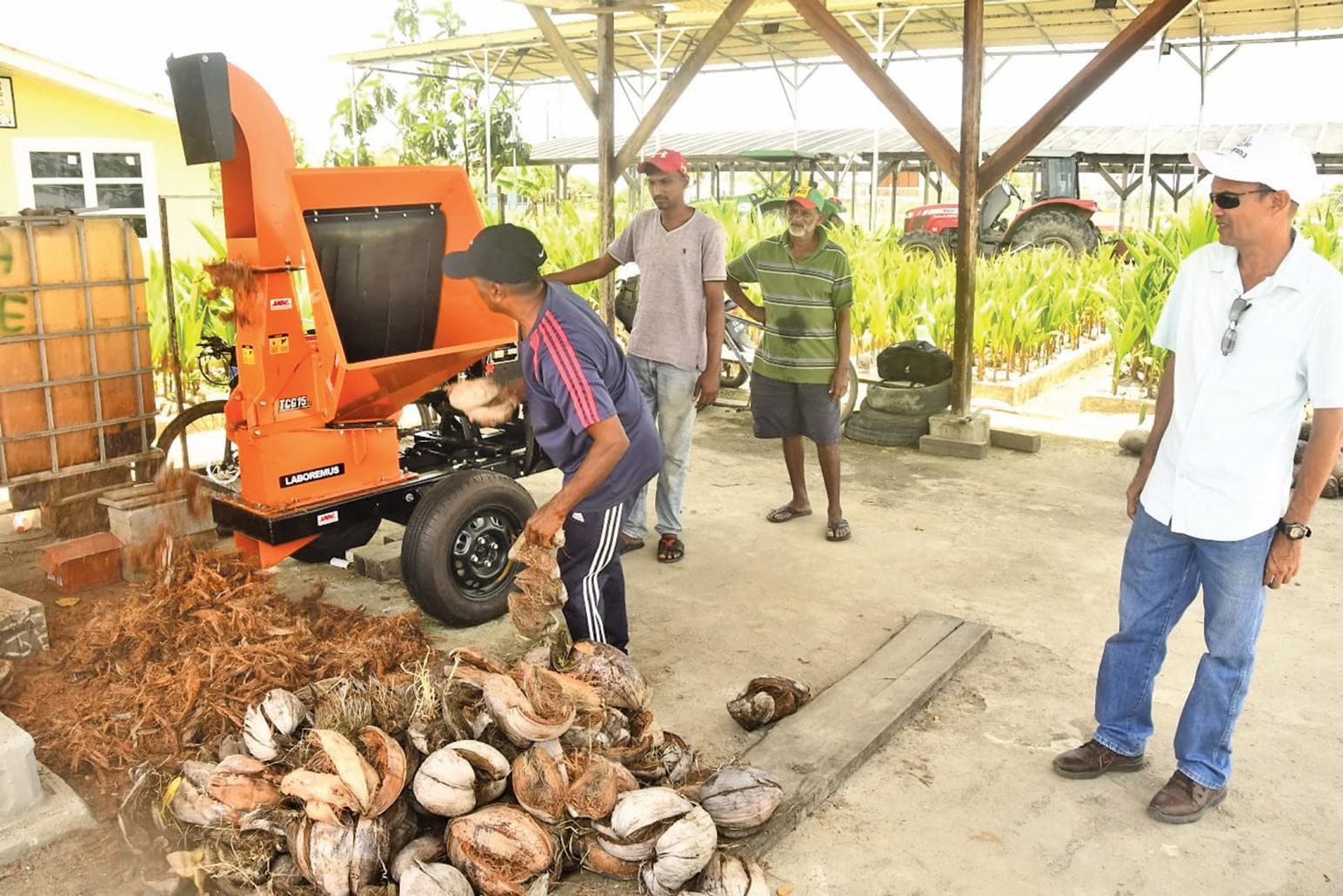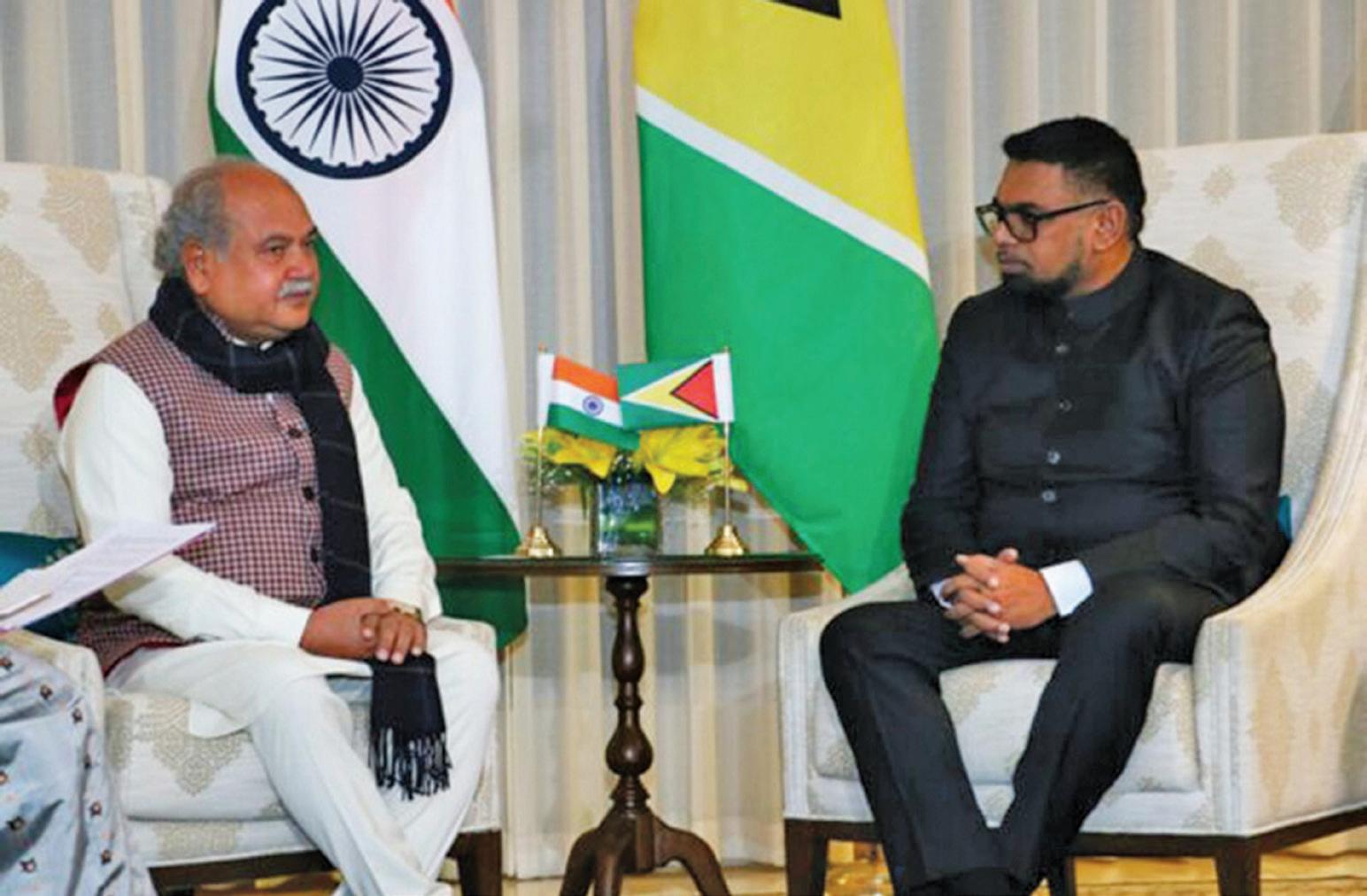Guyana: A budding regional leader
An emerging regional, global leader



— US Ways and Means Committee Chair optimistic about Guyana’s ability to advance significantly
Investor constructing $900M apartment complex at Peter’s Hall
Leading regional growth
PG 03 — resilient Guyana projected to record highest levels of economic growth over the next three years


FIRST EDITION | APRIL 2023
PG
PG 11
05
US$18,000 coconut fiber machine a game changer for agriculture

 By Cindy Parkinson
By Cindy Parkinson
THE first of its kind coconut fiber machine, which was bought and imported from Brazil by the Gov-
ernment of Guyana at a cost of over US$18,000, is a game changer for the agriculture sector.
The General Manager of Hope Estate, Ricky
Roopchand, in an interview with the Guyana Chronicle, said that two additional machines are being imported from Brazil and should arrive in the country early
next month. Additionally, under the 2023 capital programme of the estate, there are plans to buy five more coconut fiber

machines. Regarding the additional machines, the process is at the evaluation stage, and the bids were recently opened.
Roopchand related that the coconut fiber machine shreds the husk of the coconut and produces two
Continued on page 4
2 GUYANA CHRONICLE, QUARTERLY MAGAZINE, Sunday, April 9, 2023
Coconut fiber being placed in bins at Hope Estate
Coconut husk being transformed into coconut fiber and coco peat by the coconut fiber machine at Hope Estate
Leading regional growth
— resilient Guyana projected to record highest levels of economic growth over the next three years
THE Latin America and the Caribbean region will likely experience “substantially bleaker” economic conditions this year than they did last, according to a World Bank forecast, but Guyana is predicted to once again outperform its peers, with economic growth expected to average above 20 per cent over the next three years.
The international financial institution in its latest report on Latin America and the Caribbean: “The Promise of Integration Opportunities in a Changing Global Economy,” related: “The Latin America and the Caribbean (LAC) region has proved to be relatively resilient in the face of increased debt stress, stubborn inflation, and uncertainty arising from the Russian invasion of Ukraine.
“Income and employment have largely recovered from the pandemic, poverty has receded, and markets remain guardedly optimistic about the near future. However, headwinds have picked up, and the 2023 outlook is substantially bleaker than 2022.”
Guyana is the only country on course to record double-digit
growth this year and soon. According to the World Bank, the country is set to record real gross domestic product (GDP) growth of 25.2 per cent this year, 21.2 per cent next year and 28.2 per cent in 2025.
Guyana’s resilience is being demonstrated at a time when global uncertainty is rising. And, according to the World Bank, while the world may want to move from COVID-19, new variants and diseases will remain a threat.
“Strengthening resilience, both on the health and macroeconomic fronts, will be paramount. Progress remains pending in both vaccination coverage and health-system preparedness, while the institutionality of macroeconomic policy in some countries is being questioned.
“Although numerous global factors can explain the very modest 2023 growth rates, the forecasts going forward predict the same lacklustre pace of the past two decades, which remains insufficient to reduce poverty, promote inclusion, and defuse social tensions,” the World Bank said.
The evolution of the global economy is, however, providing two new areas of opportunity: The trend toward nearshoring— moving production closer to the US and European markets— and the imperative to combat climate change, which is giving the region a new comparative advantage in sun, wind, hydro, and natural capital.
Guyana is well-positioned to capitalise on those opportunities, and will be looking
to advance even further with careful fiscal planning, increased private and public investments, and an overarching Low Carbon Development Strategy (2030), that promotes sustainable development, revenue generation and essentially creates a new frontier to development.
Based on its economic performance over the past two years, Guyana has a solid foundation upon which to continue broadening its horizons and advancing significantly, especially in the medium term.
Senior Minister in the Office of the President with Responsibility for Finance, Dr. Ashni Singh, said that the achievement of real economic growth of 25 per cent over a sustainable period is a feat
looking for, I speak of broad-based and resilient growth. We have placed the highest level of importance on ensuring that we achieve strong non-oil economic growth, and that we do the things necessary today to continue to have strong nonoil economic growth going forward,” Dr. Singh had said.
that is rare in historic economic context.
“Starting from 2020 onwards, we achieved extremely strong economic growth, and the outlook remains extremely favourable,”
Dr. Singh said, adding: “In 2023, we’re looking at projected economic growth of 25.1 per cent, and into the medium term for the next three to four years, sustainable economic growth of in excess of 25 per cent.”
Though most of this projected growth is expected to be on account of the country’s burgeoning oil-and-gas sector, Dr. Singh said the government’s focus is on building out the non-oil economy.
“A lot of it is being driven by what is happening in the oiland-gas sector, but when I describe the kind of growth we are
In 2022, the non-oil sector expanded by 11.5 per cent, while growth projections for 2023 stand at 7.9 per cent. In the medium term, Dr. Singh estimates that real economic growth in the non-oil sector will be in excess of five per cent annually.

He assured investors looking to do business in Guyana that the country has established a very strong track record of growth in recent years, and has an extremely strong growth outlook for the foreseeable future.
On the subject of management of the economy, Dr. Singh said that the government has been reorienting the focus of the national budget to invest heavily in the things that matter for long-term economic growth, particularly as it pertains to addressing the country’s infrastructural gap.
GUYANA CHRONICLE, QUARTERLY MAGAZINE, Sunday, April 9, 2023 3
US$18,000 coconut fiber machine...
From page 2
products, coconut fiber and coco peat.
According to him, the coco peat has a finer particle, which, when mixed with other soil, can be used in the seedling nursery, whereas the coconut fiber is used for mulching in the cultivation of coconuts and vegetables.
“We at Hope Estate will be keeping this machine for some time so that we can generate some fiber for our own nursery. Today, we will start to press it out in our bins, and the other set of Brazilian coconuts that should be in the country by May of next month, will be the first batch to be germinated using the coconut fiber as part of the mixture,” Roopchand said.
The other advantages of using the fiber, according to the general manager, are that it holds almost ten times its mass, which will allow farmers to conserve water, and suppress weed
growth.
Roopchand said: “Currently, at Hope Estate, we are watering our nursery about three times per week, but after we add fiber to our soil, we will only have to water once per week, which cuts the cost and conserves a lot more water.”
Even though the coconut fiber machine isn’t a new idea, the general manager said that the Minister of Agriculture, Zulfikar Mustapha, and officials at Hope Estate are working towards promoting this agricultural method.
According to Roopchand: “One of the main target areas of the country, which Minister Mustapha is very passionate about and will ensure that area gets a couple of these machines, is the Pomeroon area.”
There is a lot of dumping of coconut husks in the river, which is very hazardous to the people as well as the environment, he said, adding that it is their hope that the machines
would help to alleviate the problem.

Roopchand said too that the rest of the machines will be distributed to other areas around the country.
“Because of its organic nature, coconut fiber is environmentally friendly and biodegradable, so rather than being dumped haphazardly across the environment, it can be used in a more feasible manner,” he said.
Regarding the Brazilian Green Dwarf Coconut, Roopchand said that the introduction of the threeyear variety is relatively new, and Guyana is now experiencing this type of intervention after 40 years.
Some 15 farmers have since benefited from the first 2,000 dwarf coconuts. The project, which is being rolled out by Hope Estate, the National Agriculture Research and Extension Institute (NAREI) and CARDI, is expected to benefit a total of 25 farmers.

4 GUYANA CHRONICLE, QUARTERLY MAGAZINE, Sunday, April 9, 2023
Germinated Green Dwarf Coconut
An emerging regional, global leader
— US Ways and Means Committee Chair optimistic about Guyana’s ability to advance significantly — anticipates great improvements in quality of life, development of country’s infrastructure
WITH the anticipated economic growth, which is backed by the government’s well-articulated policies and programmes, Guyana is consistently acknowledged as an emerging regional and worldwide leader.
The recent visit by the US Congressional House Committee on Ways and Means to the Latin America and the Caribbean (LAC) Region underscores Guyana’s rising stature globally.
Committee Chair, Congressman Jason Smith, during a reception hosted at the United States (US) Ambassador’s residence, said that it was on the prompting of Congressman Kelly Armstrong, who was a part of the delegation, that the committee knew that Guyana needed to be included in its tour to a few LAC nations.
“He’s really the one that has been a huge champion for Guyana, Guyana. And early on, he’s like, you need to look at this country and see what they’re doing, they’re going to be the leader in the entire region,” Smith related during the Committee’s visit to Guyana from March 16 –18.
Smith and Armstrong were part of a delegation that also included Terri Sewell, Carol Miller, Michelle Fischbach, Beth Van Duyne and Mike Carey. Guyana was the delegation’s last stop in a three-country tour, which also included stops in Mexico and Ecuador.

“There’s only three countries that we chose to
go to. And there was a reason for each one of those three countries because we wanted to make sure we recognised how important our bilateral relationships are with those three countries. And that’s why we decided to make [Guyana] the last stop of the three,” Smith said.
YOU’RE GOING TO DO IT
He was adamant that the friendship and the partnership that the American people have with Guyana will only get stronger, and is very optimistic of improvements in the quality of life and infrastructure for Guyanese.
“We want to see you all become so successful and have the most amazing infrastructure and quality of life. And you’re going to do that. You do that underneath the leadership of your president and your vice president and these members of Parliament,” Smith said.
During the visit, the delegation met with the government, members of the political opposition and officials from ExxonMobil Guyana. Smith described the visit to Guyana as “incredible” and noted the US commitment to seeing Guyana’s development.
“We are all neighbours. There’s no country that cares about your stability and your prosperity more than the United States. Always remember that and don’t forget it,” Smith said.
During the visit, President Dr. Irfaan Ali described
the USA as a “trusted partner” that stood by Guyana when it mattered most and he emphasised that Guyana will continue to be an important strategic partner to the USA.
“You are our trusted partner. We are proud of our partnership and we’re going to work together to make Guyana and the US stronger together.

“You have nothing to fear; Guyana is, and will continue to be an important strategic partner of the United States. And the opportunities here is open for both the United States and your private sector. And we want to see greater participation from the US private sector,” Dr. Ali said.
The Head of State further added: “You are one of those countries that stood up when it mattered based on your principles for democracy. That is important because you are not a fair-weather friend; your relationship is based on principles and values and that is what we value. We are working together with you and we can assure you of a government that is open. We are working to advance transparency and accountability.”
Guyana’s relationship with the US is also evidenced by the economic co-operation recorded by the countries over the years. It was reported that for the year 2021, the United States imported US$1.7 billion worth of commodities from
Continued on page 12
GUYANA CHRONICLE, QUARTERLY MAGAZINE, Sunday, April 9, 2023 5
The recent visit by the US Congressional House Committee on Ways and Means to the Latin America and the Caribbean (LAC) Region underscores Guyana’s rising stature globally (Office of the President photo)
Local food production an impetus to regional development
THE CARICOM Ministerial Taskforce (MTF) on Food Production and Food Security, in February, had announced it has collectively achieved 57 per cent of its “Vision 25 by 2025” target to date.

The announcement came after countries submitted reports detailing their production data for 2022 for targeted commodities, as CARICOM moves towards lowering the regional import bill by 25 per cent by the year 2025.
It was reported that products such as cocoa, dairy, meat, root crops, fruits, and poultry have already reached 96.13 per cent, 84.36 per cent, 72.28 per cent, 70.91 per cent, 70.77 per cent, and 70.19 per cent, respectively, for the targeted production volume set for the year 2025.
Moreover, countries such as Guyana, Belize Barbados, Trinidad and Tobago, Dominica, St. Vincent and the Grenadines, Suriname, Dominica, and Jamaica have made significant advances in the production of commodities such as ginger, turmeric, corn, soya bean, root crops, fruits, cocoa, poultry, meat, fish, table eggs, and dairy.
President Dr. Irfaan Ali had said that the Guyana government continues to open up tens of thousands of acres of new land in its bid to expand production in the country.
The report also indicated that for 2022, Guyana produced some 20,195 tonnes of ginger and turmeric, 144,289 tonnes of root crops, 21,870 tonnes of fish, and 40,749 tonnes of coconut.
In addition to the updates on member states’ production
targets, attendees were also brought up to speed on several other notable achievements.
During the 104th Special Meeting of the Council for Trade and Economic Development (COTED), Trade Policies for Animal and animal Products, a Regional Agricultural Health and Food Safety Policy, Special Sanitary and Phytosanitary (SPS) guidelines for 19 commodities, and alternative SPS settlement mechanisms were approved.
Agriculture Minister Zulfikar Mustapha had noted that the foregoing achievements are commendable, as with the mechanisms at reference in place, a level playing field is being created, thereby making way for a more straightforward trade in agricultural products intra-regionally.
“These four achievements are testimony to the hard work of the MTF. If we are allowed to increase intra-regional trade, we will be well on the way to reducing the regional food-import bill, which is the ultimate goal of CARICOM, in keeping with its food security agenda. In just one-year, collaborative efforts among member states have yielded much success,” Minister Mustapha said.
Minister Mustapha, who chairs the CARICOM MTF, indicated that several priority areas have been identified for 2023, among them agriculture insurance and financing, trade and E-agriculture, resource mobilisation, and trade support. These, he explained, will help to advance the efforts of the MTF and CARICOM as together they
work towards achieving ‘Vision 25 by 2025’.
Research has shown that the region imports, from out of the region, approximately 80 per cent of the food that it consumes, which amounts to approximately US$4 billion.
As Guyana continues to advance its efforts to improve food security, authorities have begun talks with India to leverage research and innovative technologies with the aim of boosting local production in several agricultural industries.
Vice-President, Dr. Bharrat Jagdeo, following a visit to the Asian nation, said works have begun to solidify a work plan that will allow for meaningful collaboration with experts from
the South-Asian country, specifically in the areas of expertise and technology.
The initiatives discussions sparked during President, Dr. Irfaan Ali’s visit to India in January 2023. After that visit, the Vice President travelled to India to solidify the expanding partnership with India.
“We met also on the agricultural sector and we are looking at a consistent plan to look at higher levels of productivity in the agricultural sector [and] at this point in time in every industry and to move from a peasant type farming into agri-business,” Dr. Jagdeo said.
He further explained that Guyana will need varying expertise for this to happen.
“We need the expertise from many parts of the world to transform these industries into agri-businesses.”
In India, he said, “there are higher levels of productivity, the variety of cane will give you probably two to three times the output that we are getting from a single acre of cane here; similarly, the rice varieties yield much more.”
Beyond these initiatives, the Vice President highlighted that representatives of both nations are discussing the expansion and modernisation of tissue culture facilities in Guyana.
Tissue culture involves the cultivation of plant cells, tissues, or organs on specially formulated nutrient media. Under the
right conditions, an entire plant can be regenerated from a single cell.
“With tissue culture you can do millions of plants in a short period of time… It will be a big boost to say our cane farming industry. We need planting material now of a high quality.”
He also shared that India is able to see exceptional yields with its use of nano-fertilisers which is said to produce high-yielding crops and is more advantageous compared to the traditional fertilisers used here in Guyana.
Nano-fertilisers are said to increase soil fertility yield and quality parameters of the crop; they are nontoxic, and can also minimise cost while maximising profit.

“They’re really great at some things like nano fertilisers, so we will explore the use of nano fertiliser. We’re told that two pounds of nano fertiliser can be as effective as say about 45 pounds of regular fertilisers, Dr Jagdeo explained.
India is an undisputed powerhouse in agricultural production, the Vice President said, and it is against this backdrop Guyana is forging ahead with collaborative initiatives.

“They practically feed 1.4 billion people themselves with very little import and with high levels of productivity.”
He added, “So we are hoping, over the next few months, that a lot of these specialists would be recruited and brought to Guyana, to give a big boost to the agriculture sector and expand its productivity.”
6 GUYANA CHRONICLE, QUARTERLY MAGAZINE, Sunday, April 9, 2023
— research, technological capabilities of India being leveraged for advancement of Guyana’s agriculture sector
President Dr Irfaan Ali (right), engages Union Agriculture and Farmers Welfare Minister, Shri Narendra Singh Tomar
President Dr. Irfaan Ali had said that the Guyana government continues to open up tens of thousands of acres of new land in its bid to expand production in the country

GUYANA CHRONICLE, QUARTERLY MAGAZINE, Sunday, April 9, 2023 7















8 GUYANA CHRONICLE, QUARTERLY MAGAZINE, Sunday, April 9, 2023















GUYANA CHRONICLE, QUARTERLY MAGAZINE, Sunday, April 9, 2023 9















10 GUYANA CHRONICLE, QUARTERLY MAGAZINE, Sunday, April 9, 2023
Investor constructing $900M apartment complex at Peter’s Hall
A developer, Pope Properties Inc., is seeking to establish a $900 million high quality, luxurious apartment complex, in St Peter’s Hall on the East Bank Demerara, within the gated community in Republic Gardens.
Housed on approximately 20,000 square feet of land, at a height of 14.6 meter, the property will accommodate 14 units, comprising three, two and one-bedroom apartments, each outfitted with internet, telephone and cable services.
Scheduled for completion by the end of June 2023, the proposed three-storey apartment complex is set to be designed with modern amenities, in keeping with international standards, according to the company.
The apartments will be fully furnished and outfitted with hot and cold water, air-conditioning units, pot fillers (over the stove), microwave ovens, refrigerators
and toasters among others things, the company said.
“While the primary goal is to provide medium to long-term, comfortable housing solutions demanded by the oil and gas and supporting sectors, to accommodate expatriates, the apartment complex will welcome all guests from all sectors who desire and can afford comfortable, modern and convenient accommodation,” the
company related.
The company has already commenced conversations with interested stakeholders who will most likely require accommodation.
Construction of the apartment building commenced in 2019, shortly after the purchase of the land. The facility was inspired by an overseas-based Guyanese family, desirous of aligning with Guyana’s development
trajectory, specifically the growing demand for housing.
The company is placing particular emphasis on assurances of top-notch safety standards, noting that “Pope Properties Guyana Inc. intends to encourage a positive safety culture among employees at all stages of the project’s development (construction and operation), which will transition to residents of the apartment.”
The apartment building is being constructed in an area zoned for residential purposes, which also includes several similar ongoing construction activities. With Republic Gardens being developed in 2014, there are still several unoccupied lots and incomplete structures in many sections of the community.
The establishment of the apartment building is ex -
pected to make a positive contribution to Guyana’s economic sector, through the provision of direct and indirect employment during the construction and operational phases of the project.
“During the construction phase, approximately 20 jobs will be directly created, while 5 persons will be employed during the apartment’s operation. In addition, indirect employment will be created through the purchase of goods and services from suppliers and subcontractors,” the company has said.
“The establishment of this apartment will no doubt make a positive contribution to Guyana’s housing sector within which there is a growing demand for housing. Finally, the establishment of the apartment with modern amenities, will create a positive economic impact, through fiscal incentives such as payment of taxes.”

Strong non-oil economy demonstrates Guyana’s prowess
GUYANA’S ability to expand its non-oil economy despite global challenges shows the country’s prowess, the Ministry of Finance had posited, while reflecting on a December 2022 report from the InterAmerican Development Bank (IDB).
According to the IDB’s quarterly publication: “Caribbean Economics: The Headwinds-Facing the Post-Pandemic Recovery,” Guyana continues to be a ‘booming economy,’ with oil production driving growth in exports, Gross Domestic Product (GDP) and government revenues and expenditures in the medium term.
Importantly, it noted that the non-oil economy had a “better-than-expected turnout of 9.6 per cent for 2022, compared to 7.7 per cent projected in the country’s 2022 budget.”
The growth in the nonoil economy, the Ministry of Finance said, demonstrates Guyana’s economic prowess that has been derived from sound governmental stewardship.
“Recognizing the importance of a strong, diversified economic base, the President Ali-led government in the earliest days of oil production, placed the highest level of importance
on a strong non-oil economy,” the release stated.
The Ministry of Finance’s release reminded the public that Guyana holds portfolio responsibility for Agriculture and Food Security in the Caribbean Community (CARICOM).
Through Guyana’s efforts, the bloc has adopted Guyana’s plan to reduce CARICOM’s food imports

by 25 percent by 2025.
Developments in this sector alone, the ministry reasoned, illustrate Guyana’s keen focus on divarication and expanding its non-oil economy.
These efforts, the Finance Ministry said, were acknowledged in the IDB report.
The report noted that Guyana is among the countries in the region that or-
ganised investment forums to promote technological improvements in agriculture and attract foreign direct investment.
The report also pointed out that Guyana “rapidly moved from being a net importer of agricultural products and mineral fuels, representing eight percent of GDP in 2018 and 2019, to being a net exporter of the same commodities, with a trade surplus of 16 percent of GDP in 2020 and 31 percent in 2021 with the rest of the world.”
Generally, this recent publication examined Caribbean economies and how they have been performing during the post-pandemic period. It also assessed what was done by regional governments to cushion the impact of global challenges such as the COVID-19 pandemic and resulting supply-chain disruptions.
In Guyana’s case, the
IDB publication related that the International Monetary Fund (IMF) increased, in October, its estimates for oil production and GDP growth as a result of incorporating oil production from an additional Floating, Production, Storage, and Offloading (FPSO) vessel that led to higher levels of production.
It was noted that the country’s GDP growth was “expected to significantly expand in 2022” and “includes stronger recoveries in some non-oil sectors.”
Simultaneously, it acknowledged that Guyana’s main export flows and Guyana’s volume of exported goods was projected to rise by an annual average of 50 per cent over 2022 to 2026 in contrast to the IMF’s April estimate of 22.5 per cent, because of higher global energy prices.
GUYANA CHRONICLE, QUARTERLY MAGAZINE, Sunday, April 9, 2023 11
An artist’s impression of the proposed apartment building
Gas: The new frontier after oil
GUYANA, the South American country that is home to the world’s largest oil discoveries in a decade, next wants to develop its mostly untapped natural gas reserves, Vice President Bharrat Jagdeo had said.
The nation aimed to diversify its oil sector and secure new sources of revenue before the energy transition to renewables reduced demand for fossil fuels, Jagdeo said.
In just a few years, Guyana has emerged as an oil powerhouse with more than 11 billion barrels of recoverable oil and gas found by a consortium led by Exxon Mobil (XOM.N).

Exxon’s gas produc -
Guyana.
tion at the massive Stabroek Block is not being used by Guyana or sold abroad. Exxon currently reinjects the gas to main-
tain the pressure of producing oil wells.
But Jagdeo told Reuters the government saw gas as providing a way for
transforming the nation of about 800,000 people.
“We believe gas must be monetized,” he said in an interview prior to this
address at the recent CERAWeek energy conference in Houston.
The vice president plans to use the conference to promote 14 untapped offshore blocks to a global audience of energy executives and ministers.
The government expected to receive this year a plan it had requested from Exxon for developing the company’s gas discoveries, Jagdeo said. The country was also discussing with technicians and consultants a national strategy to supply gas to industries ranging from petrochemicals to exportable liquefied natural gas (LNG), he said.
“We’ve had a number of those companies come
to us and say should you do that, we want to be considered,” he said of the potential to become an LNG exporter. He declined to identify which LNG developers had approached the government.
Exxon, which Guyana says could be required to relinquish 20 per cent of its 6.6-million-acre Stabroek Block, has not developed its Pluma discovery, which was announced in 2018.
“If they don’t utilize it, they have to give it up,” Jagdeo said. Pluma is close to Guyana’s maritime border with Suriname, where other oil and gas discoveries have been made. (Reuters)
An emerging regional...
pansion of 11.5 per cent in non-oil real gross domestic product (GDP).
And as the countries look to enhance bilateral relations, Guyana stands to benefit immensely since the country is on a towering path with a vibrant oil and gas sector, productive nonoil sectors and prudent fiscal planning and management.
A THRIVING ECONOMY
Despite global and local challenges, Guyana has managed to maintain a thriving economy through careful fiscal planning and the creation of an environment that has fostered improved performances in various economic sectors.

In presenting the government’s massive $781.9 billion 2023 budget to the National Assembly, Senior Minister in the Office of the President with Responsibility for Finance, Dr. Ashni Singh, said the economy grew by 62.3 per cent overall in 2022 in real terms, with a “very strong ex -
“At 62.3 per cent overall real growth, Guyana would be the fastest growing economy in the world in 2022,” Dr. Singh said.
The country’s performance was on account of better-than-expected output in the oil and gas sector, and the government’s policies focused on supporting the traditional and new and emergent non-oil pillars of the economy, helped ensure stronger and more broadbased growth than originally anticipated.
The country’s performance was on account of better-than-expected output in the oil and gas sector, and the government’s policies focused on supporting the traditional and new and emergent non-oil pillars of the economy, helped ensure stronger and more broadbased growth than originally anticipated.
“Speaker, with continued interventions and policies geared at building a
resilient economy, real GDP is projected to grow by 25.1 per cent this year, a rate of growth which currently puts Guyana among the top five fastest growing economies in 2023,” Dr. Singh had said.
This position, according to the minister, could be largely attributed to further ramping up of oil production anticipated in the Stabroek Block.
The country is using returns from the oil and gas sector to fund transformative projects and move the country towards the use of renewable energy.
With the gas-to-energy project, Guyana is also on the path to lowering electricity costs and encouraging investments in manufacturing and other areas.
There is also great emphasis on education, healthcare and social welfare, all of which positions the country to become an economic powerhouse and regional leader, as foreseen by the US official.
12 GUYANA CHRONICLE, QUARTERLY MAGAZINE, Sunday, April 9, 2023
From page 5
With the anticipated economic growth, which is backed by the government’s well-articulated policies and programmes, Guyana is consistently acknowledged as an emerging regional and worldwide leader (Office of the President photo)
Investment opportunities available in every corner of Guyana

AS the government continues to work aggressively to advance the country’s infrastructural and economic development, Chief Investment Officer and Head of Guyana Office for Investment (GO-Invest), Dr. Peter Ramsaroop, has said that the investment opportunities that are available are limitless.
During a recent interview with the Guyana Chronicle, Ramsaroop explained that the massive investment that the government is making in the public sector is encouraging investments in the private sector.
He noted that if the private sector is to look at where government is initiating development, they would recognise that there are many activities that they can invest in.
“There’s no ending to investment opportunities in the near future. If you follow the budget, and you see government expenditures in all the regions, whether it’s roads, hospitals, its schools, it’s all initiating our economic activity. For example, we’re building out the road, whether it’s to Mabura, in the Kwakwani or Berbice area that opened up new lands, which creates opportunities for so many sectors. The agriculture sector then is boosted and then other sectors, retail services, telecommunication, all these other sectors follow along,” he explained.
GO-Invest serves as a primary contact for investors and liaising with government
agencies throughout the investment process.
According to Ramsaroop, there is no shortage of capitalisation of Guyana’s economic boom, as Guyana continues to be a hub for investment both from the foreign direct investments and local investors.
“Government is implementing a lot of ease of doing business changes, and the private sector has stepped up to the challenge. The private sector is the engine of growth, so government can only facilitate and contribute to the public sector, but the private sector takes that lead and then works alongside government to make the economy run,” Dr. Ramsaroop noted.
Aside from government’s investment in infrastructure, Dr. Ramsaroop explained that the CARICOM 25 by 25 initiative is also driving massive investment in the area of agro-processing, and the Guyana Investment Office continues to see a lot of interest being generated in this sector.
The 25 by 25 initiative is a programme whereby the Caribbean region is striving to reduce its food import bill by at least 25 per cent by 2025.
“As the president solves the 25 by 25 CARICOM food bill, these sectors now are stepping up whether it is mega farm and soybean and corn seed to agro-processing. We’re in discussion with large meat [companies] for example regarding the pack-

aging of meat for export,” he said before drawing attention to a woman whose business revolves around packaging pepper pot in a box and others like her who are marketing creative products.

“In Linden someone is producing split peas cook up in a packet. We’ve had interest whereby the Barbados military wants to buy those so that they can put it in a military meal packages. If you follow the President’s budget, when folks align to that area you see that there is a lot of investment opportunities,” he said.
Outside of working to put the necessary infrastructure in place, and making investments in the public sector, the government also has a number of target areas where the private sector can capitalise on.
According to Ramsaroop, his office is also focusing heavily on local content.
“We are working on promoting our priority sectors, being agriculture, technology, and working on helping to get individuals investing more in those sectors and looking to see how we can increase incentives or other sectors to be energised,” Dr. Ramsaroop said.
While noting the significant contributions of investors, he said that the local investors have created thousands of jobs in the last year and have invested billions of dollars into the economy.
“So, we will continue to focus on putting our local content to work. Push for
GUYANA CHRONICLE, QUARTERLY MAGAZINE, Sunday, April 9, 2023 13
foreign direct investors to work closely with local investors, through joint ven-
tures, and consortiums and continue to develop, and help facilitate investment
development in Guyana,” he added.

14 GUYANA CHRONICLE, QUARTERLY MAGAZINE, Sunday, April 9, 2023

GUYANA CHRONICLE, QUARTERLY MAGAZINE, Sunday, April 9, 2023 15

16 GUYANA CHRONICLE, QUARTERLY MAGAZINE, Sunday, April 9, 2023







 By Cindy Parkinson
By Cindy Parkinson






























































